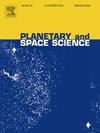月球尘埃模拟物在紫外辐射下双极电荷分布的测量
IF 1.7
4区 物理与天体物理
Q3 ASTRONOMY & ASTROPHYSICS
引用次数: 0
摘要
即将到来的登月任务代表着新的科学机遇和挑战。风化层的静电特性与太阳风相结合,使其飞扬并粘附在几乎任何表面,这对未来的载人和机器人任务构成了威胁。了解典型环境下月球土壤的电荷状态是确保月球任务安全的关键一步。虽然暴露在太阳紫外线下的全球一级效应是使土壤带正电,但过去的实验表明,传输的尘埃可能带负电。这种反直觉的行为随后得到了模型的支持,模型解释了负电荷的存在,但也预测了正电荷的存在。为了研究典型环境下粉尘的充电行为,我们开发了一种基于偏振敏感传感器的实验方案,该传感器用于测量单个粉尘颗粒的电荷,精度约为1fc。利用JSC-1A高真空月球尘埃模拟装置获得的第一组测量结果揭示了暴露于紫外线下月球尘埃在风化层中净电荷的双极性性质。事实上,检测到正尘埃和负尘埃,支持模型所建议的风化层充电过程的复杂性。本文章由计算机程序翻译,如有差异,请以英文原文为准。
Measurement of bipolar charge distribution of lunar dust simulant under VUV irradiation
Upcoming missions to the Moon represent new science opportunities and challenges. The electrostatic nature of the regolith combined with the solar wind makes it loft and adhere to almost any surface, which represents a threat for future manned and robotic missions. Understanding the charge state of the lunar soil under a representative environment is a key step towards ensuring safe lunar missions. While the global first order effect of exposure to the Sun's UV is to charge the soil positively, past experiments suggested that the transported dusts could be charged negatively. This counter-intuitive behavior was then supported by modeling, which explained the existence of negative charges but also predicted that of positively charged ones. To investigate the charging behavior of dust under a representative environment, we developed an experimental protocol based on a polarized sensitive sensor dedicated to the charge measurement of single dust grains with an accuracy of about 1 fC. The first set of measurements obtained with JSC-1A lunar dust simulants in high vacuum reveals the bipolar nature of lunar dust net charge in the regolith when exposed to UVs. Indeed, both positive and negative dusts were detected, supporting the complexity of the regolith charging processes suggested by the models.
求助全文
通过发布文献求助,成功后即可免费获取论文全文。
去求助
来源期刊

Planetary and Space Science
地学天文-天文与天体物理
CiteScore
5.40
自引率
4.20%
发文量
126
审稿时长
15 weeks
期刊介绍:
Planetary and Space Science publishes original articles as well as short communications (letters). Ground-based and space-borne instrumentation and laboratory simulation of solar system processes are included. The following fields of planetary and solar system research are covered:
• Celestial mechanics, including dynamical evolution of the solar system, gravitational captures and resonances, relativistic effects, tracking and dynamics
• Cosmochemistry and origin, including all aspects of the formation and initial physical and chemical evolution of the solar system
• Terrestrial planets and satellites, including the physics of the interiors, geology and morphology of the surfaces, tectonics, mineralogy and dating
• Outer planets and satellites, including formation and evolution, remote sensing at all wavelengths and in situ measurements
• Planetary atmospheres, including formation and evolution, circulation and meteorology, boundary layers, remote sensing and laboratory simulation
• Planetary magnetospheres and ionospheres, including origin of magnetic fields, magnetospheric plasma and radiation belts, and their interaction with the sun, the solar wind and satellites
• Small bodies, dust and rings, including asteroids, comets and zodiacal light and their interaction with the solar radiation and the solar wind
• Exobiology, including origin of life, detection of planetary ecosystems and pre-biological phenomena in the solar system and laboratory simulations
• Extrasolar systems, including the detection and/or the detectability of exoplanets and planetary systems, their formation and evolution, the physical and chemical properties of the exoplanets
• History of planetary and space research
 求助内容:
求助内容: 应助结果提醒方式:
应助结果提醒方式:


